07 December 2022
Grass10 Updates and Newsletter – 6th December
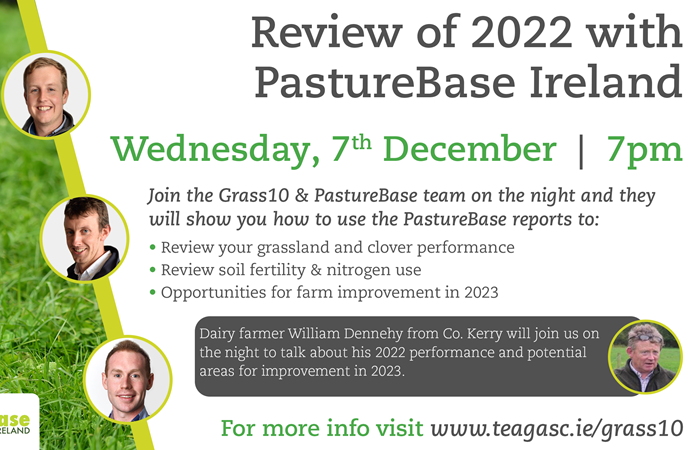
This week in the Grass10 newsletter hear from Caitlin Looney and Michael Egan, researchers from Teagasc Moorepark give us an update from the Clover150 programme plus all the usual updates from the Grass10 team
PastureBase Ireland – Dairy Figures
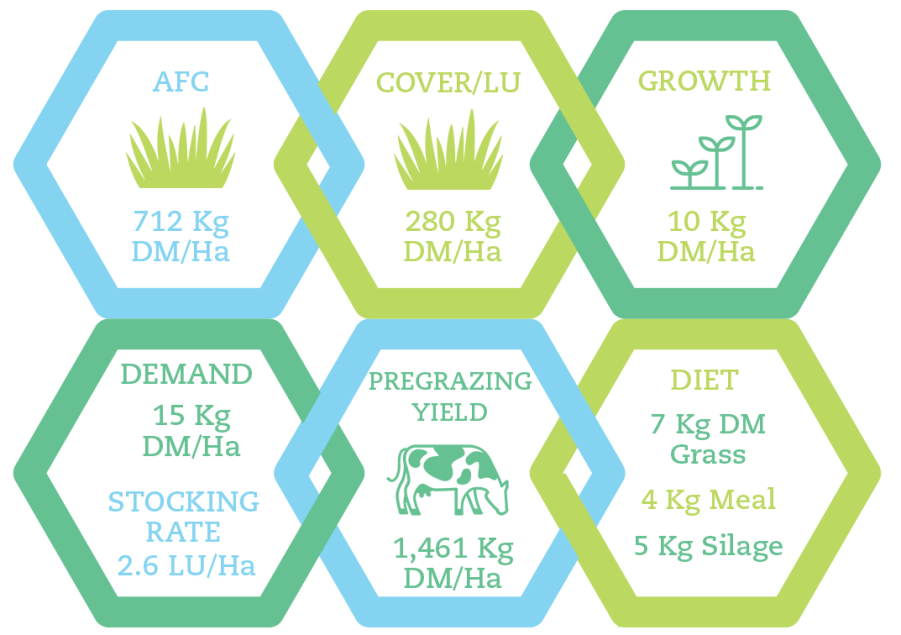
- Average Farm Cover – 712 Kg DM/Ha
- Cover/LU – 280 Kg DM/Ha
- Growth – 10 Kg DM/Ha
- Demand 15 Kg DM/Ha – Stocking rate 2.6 LU/Ha
- Pregrazing yield – 1,461 Kg DM/Ha
- Diet – 7 Kg DM Grass – 4 Kg Meal – 5 Kg Silage
Grass 10 Weekly Tips
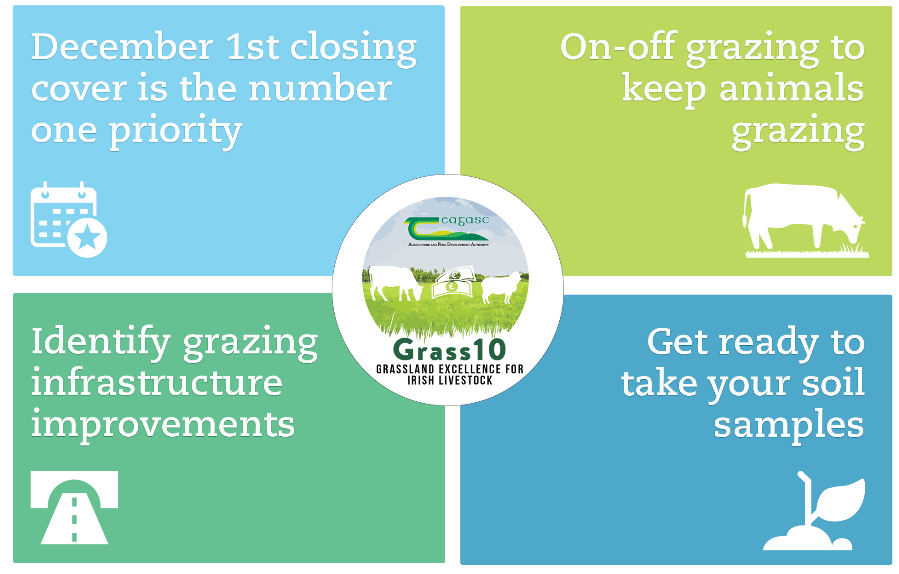
- Complete your closing Average Farm Cover this week
- Tune in to our webinar “Review of 2022” tonight 7th December at 7pm
- Get prepared to soil sample your farm this winter
- The 2022 PastureBase Scorecard is live
Complete your closing Average Farm Cover this week
Looking at the PastureBase data, most dairy and drystock farms are currently at 700 Kg DM/Ha. This is on target for the majority of farmers which is very encouraging. Farmers with a high demand in spring should cease grazing immediately so as not to run farm cover too low.
Don’t forget to record your final grass walk of 2022 on PastureBase Ireland. Recording a closing AFC will allow you to quantify the amount of grass grown for 2022 on your farm & allow you to accurately measure over winter growth when you walk the farm next Spring. Ensure you have 20 farm walks entered throughout 2022 on PastureBase Ireland to meet your derogation plan requirements. The targets, with heaviest covers to carry over winter in brackets, are below:
2.5 LU/ha – 650-700 KgDM/ha (1300-1400 KgDM/ha)
3.0 LU/ha – 700-750 KgDM/ha (1500-1600 KgDM/ha)
3.5 LU/ha – 750-800 KgDM/ha (1600-1700 KgDM/ha)
A good start is half the battle, and high grass availability in the spring is a brilliant start. This is in your control! Every day at grass next spring will be worth about €4 per cow per day on a dairy farm, or about €2.75 per LU on a beef farm.
Tune in to our webinar “Review of 2022” tonight 7th December at 7pm
When you complete your closing AFC on PastureBase Ireland, it is an ideal opportunity to review the suite of reports on PastureBase for your farm. Do you need help to guide you through the information that is available?
Join the Grass10 & PastureBase team tomorrow night, Wednesday 7th December at 7pm where they will discuss 2022 information from PastureBase and identify areas for improvement on your farm for 2023. See info below to register
Get Prepared to soil sample your farm this winter
Soil sampling is the most important factor when it comes to managing soil fertility on Irish farms. Soil sampling results give us accurate information on our soil nutrient status and give us a good basis to work off when it comes to tailoring our lime, slurry and chemical fertiliser application. December/ early January is a great time to take soil samples before any chemical fertiliser/ slurry is applied on farms. Talk to your Teagasc advisor and make a plan for soil sampling your farm this winter.
The 2022 PastureBase Scorecard is live!
A big hit last year with farmers was the PastureBase Scorecard. It is a self-appraisal of your use of PastureBase to achieve grazing excellence. It requires you to review your PastureBase reports which highlight the grazing, clover and nutrient performance of your farm for 2022. If you haven’t already, make this an absolute priority in the next few weeks. Put aside 1-2 hours to sit down, and take the time to go through your reports and fill out the scorecard. Working smart is not limited to out on the farm. Some of the best farmers in the country are using the PastureBase Scorecard to identify where they can make further improvements in 2023. PBI Scorecard
PastureBase Ireland – Drystock Figures
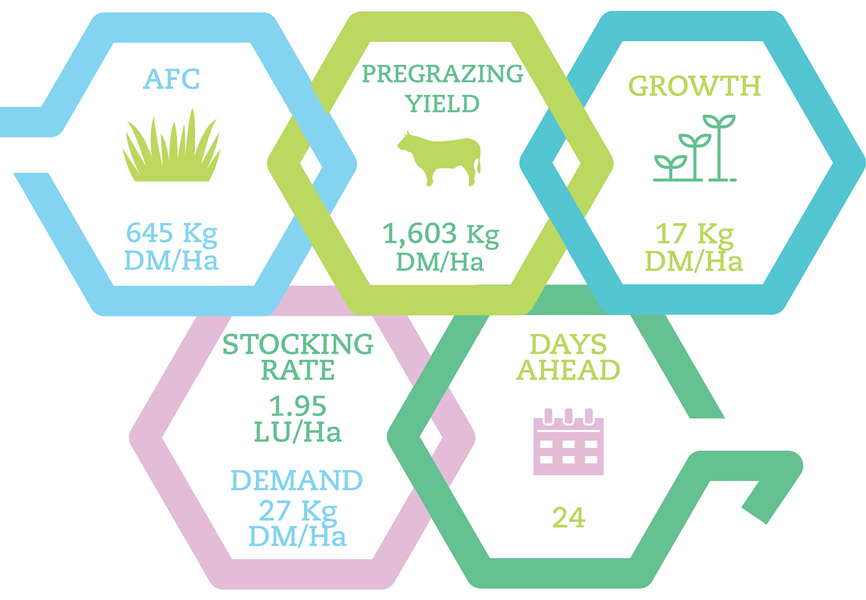
- Average Farm Cover – 669 Kg DM/Ha
- Pregrazing yield – 1,587 Kg DM/Ha
- Growth – 11 Kg DM/Ha
- Stocking rate – 1.43 LU/Ha
- Demand – 15Kg DM/Ha
- Days ahead – 46
Review of 2022 with PastureBase Ireland Webinar
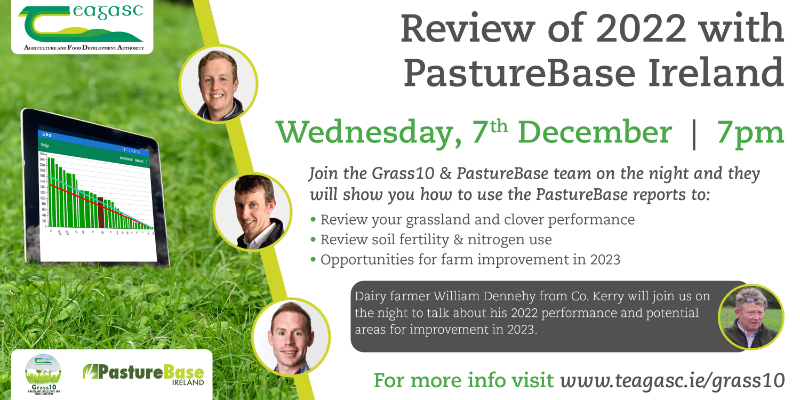
Are you looking to review your PastureBase Ireland data but dont know where to get started?
On tonight, 7th December at 7pm the Grass10 & PastureBase Ireland team will host a webinar in order to aid people to understand their PastureBase Ireland data and identify areas for improvent in 2023.
We are delighted to be joined by Co. Kerry dairy farmer William Dennehy on the night where we will discuss his PastureBase data, with a particular focus on the performance and nutrient usage on grass clover swards.
The Clover Reporter – Update from the Clover150 Programme 2022
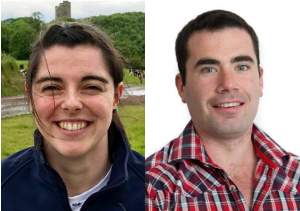 Caitlin Looney and Michael Egan, researchers from Teagasc Moorepark give us an update from the Clover150 programme.
Caitlin Looney and Michael Egan, researchers from Teagasc Moorepark give us an update from the Clover150 programme.
The Clover150 programme was established in 2021. It is made up of 35 farmers looking to increase clover content in their swards and therefore reduce nitrogen surplus and chemical nitrogen application on their farms. There is a range of land types, geographic spread and enterprises, with four main objectives;
- Reduce Nitrogen (N) Surplus <130 kg N/ha and an increase N use efficiency >40%
- ≤ 150 kg N fertiliser/ha
- Average sward clover content of 20 – 25%
- ≥ 14 t DM/ha grown
Results to date:
Clover was established on farms by reseeding and oversowing, with double the area oversown. The area of the farm in clover at the end of 2022 was 64%, with an average sward clover content of 18%. There was no variation in sward clover content between reseeded and oversown paddocks, at 19% and 18%, respectively. Nitrogen fertiliser reduced by 18 kg N/ha across the 35 farms from 2021 to 2022, however there was a significant increase in the proportion of organic N used on farm at 15 kg N/ha.
Grass grown reduced on farm by 1 t DM/ha, to the end of November, with a large proportion of this reduction caused by the drought in late summer. On a subset of 16 matched farm that had N data reported on PBI from 2020 to 2022, there was a 28% (66 kg N/ha) reduction in chemical N usage between 2020 and 2022, and a 1.1 t DM/ha reduction in the same period.
Key recommendation from the Clover150 programme:
Clover will be the main innovation responsible for a rapid reduction of chemical N on farm as shown on Clover 150 farms. Below are recommendations developed form the project;
- Carry out a N plan for 2023 on PBI
- Identify and tailor N application for individual paddocks
- Greater use of soiled water in summer
- ~2,500 gallons of soiled water can successfully replace chemical N in summer rotations on established clover swards (> 25% clover)
- Continue to increase clover area and content
- Over sow approximately 15% of farm in late March/April
- Reseed 5 – 10% per year
- Maintain balance of grass and clover – average 20-25% annually
- 10-15% in spring
- 20-25% in summer
- < 40% in autumn
Table 1: Herbage production and Nitrogen application on the Clover50 farms for 2021 and 2022
| Annual Tonnage | N applied – kgN/ha | N applied – kgN/ha | N applied – kgN/ha | Area of farm under clover | |
|---|---|---|---|---|---|
| 2022 | 14.5 | 192 – 159 | 30 – 16 | 118 – 31 | 64% |
| 2021 | 13.5 | 195 – 177 | 25 – 15 | 89 – 33 | 45% |
| Difference | 1.0 | -3 (-18) | + 5 – +1 | +29 – (-2) | +19 |


